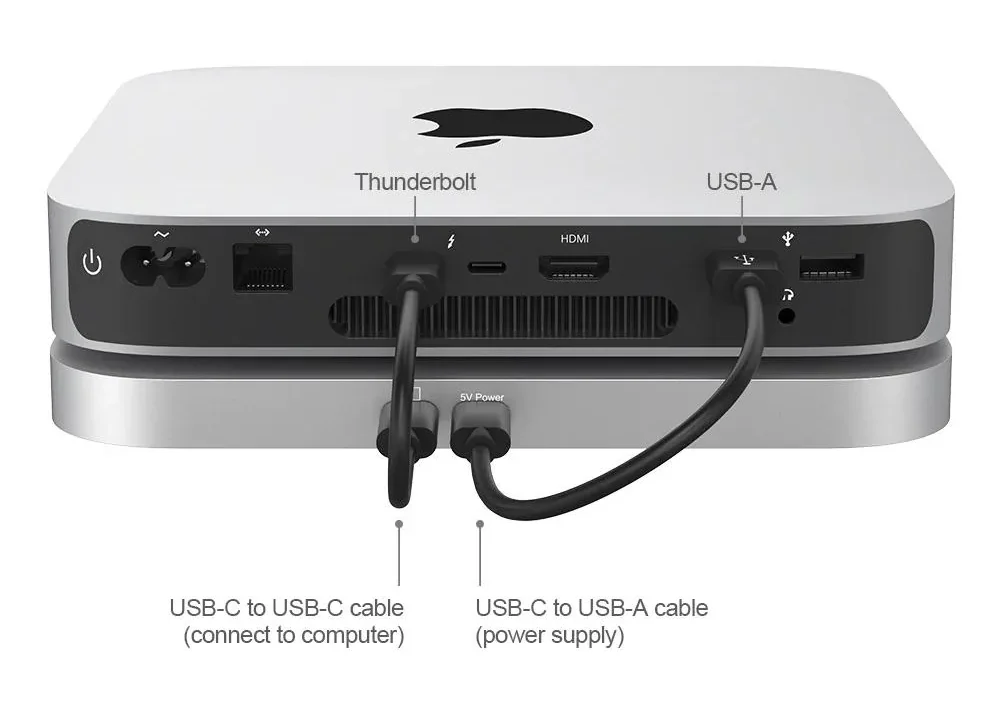- The Mac mini presents a more budget-friendly option than the MacBook Air, utilizing separate peripherals in a desktop setup.
- The Mac mini offers superior performance and extensive port options, making it a versatile choice for users.
- The Mac mini’s design as a compact desktop with a sturdy aluminum build promotes better ergonomics and integrates seamlessly into workspaces.
Mac mini and the MacBook Air are excellent choices for creatives within the Apple ecosystem. The MacBook Air, often considered the best MacBook, is popular for its built-in display, internal battery, and camera, offering a convenient all-in-one solution.
However, the Mac mini is worth considering for its lower price, better performance, support for more external displays, and a wider variety of ports. Here is a comparison table highlighting features that might make the Mac Mini better than the MacBook Air.
Comparison Table
| Feature | Mac Mini | MacBook Air |
|---|---|---|
| Starting Price | $599 | $999 (M2), $1,099 (M3) |
| Single-core Performance Score | 2,651 | 2,595 |
| Multi-core Performance Score | 14,307 | 9,740 |
| Built-in Display | No | Yes |
| Internal Battery | No | Yes |
| Camera | No | Yes |
| Ports | More Ports | Fewer Ports |
| External Display Support | Three External Displays | 1 or 2 Displays |
| Cooling System | Fan (Quiet) | Fanless (Silent) |
| Design | Compact Desktop (19.7cm x 19.7cm x 3.6cm) | Portable laptop |
Cost Efficiency

Performance And Optimization

The MacBook Air M2 Max achieves a Geekbench score of around 2,595 for single-core performance and 9,740 for multi-core performance, whereas the Mac mini M2 Pro scores 2,651 for single-core performance and 14,307 for multi-core performance, indicating better optimization and higher performance.
The MacBook Air is fanless and silent. Although the Mac mini has a fan, it remains quiet and effectively handles intensive tasks without overheating. This makes the Mac mini excel in demanding tasks and multitasking, making it a better choice for power users.
Expandability And Upgradeability

Unlike the MacBook Air, the Mac mini offers more ports and connectivity options, making it a versatile desktop choice. The Mac mini includes up to four Thunderbolt 4 ports, two USB-A ports, an HDMI port, a Gigabit Ethernet connector (upgradeable to 10Gb Ethernet), and a 3.5mm headphone jack, enabling direct connection of multiple peripherals without many adapters.
Further, unlike the MacBook Air, the Mac Mini allows users to upgrade certain components like RAM and storage. This not only extends the life of the machine but also allows it to adapt to changing needs.
External Display Support

The MacBook Air with an M2 chip supports only one external display at a 6K resolution and 60Hz refresh rate. The M3 MacBook Air allows for one 6K display and one 5K display at 60Hz if the built-in display is closed.
In contrast, the Mac mini offers greater flexibility for multiple external displays. Even the entry-level M2 Mac mini supports up to two external displays: one 6K display at 60Hz and either one 5K display at 60Hz via Thunderbolt or one 4K display at 60Hz via HDMI.
If you go for the M2 Pro Mac mini, it can handle up to three external displays. Therefore, the Mac mini is ideal for users requiring extensive external display support, making it a versatile and cost-effective choice for creating an efficient workstation setup.
Design And Build

The Mac mini is designed as a compact desktop solution, measuring 19.7cm by 19.7cm and 3.6cm tall. Despite lacking portability due to its lack of an internal battery, its small footprint makes it ideal for fitting behind monitors and integrating seamlessly into a workspace.
Like the MacBook Air, the Mac mini is built from sturdy aluminium, ensuring durability and a professional aesthetic suitable for desktop environments. Its robust build contributes to longevity, making it a reliable choice for users seeking a durable, long-lasting computing solution.
Ergonomics

The Mac mini’s desktop orientation naturally promotes better ergonomic practices. I’ve experienced this firsthand. Years ago, relying on a laptop for daily work caused severe back pain due to constant stooping.
Transitioning to a Mac mini’s desktop setup naturally encouraged better ergonomics. Pairing it with an adjustable monitor improved my posture and overall comfort, eventually eliminating my back pain.
Verdict
If you need a powerful and flexible desktop setup for multitasking with applications, you can choose the Mac mini with the M2 or M2 Pro chip because of its superior performance, extensive port selection, and ability to support multiple external displays.
This setup promotes better ergonomics with an adjustable monitor and remains cost-effective, even after purchasing necessary peripherals separately. This choice offers a powerful, efficient, and budget-friendly solution, making the Mac mini the clear winner over the MacBook Air.
Thank you! Please share your positive feedback. 🔋
How could we improve this post? Please Help us. 😔
[Reviews Specialist]
Usman Saleem brings 8+ years of comprehensive PC hardware expertise to the table. His journey in the tech world has involved in-depth tech analysis and insightful PC hardware reviews, perfecting over 6+ years of dedicated work. Usman’s commitment to staying authentic and relevant in the field is underscored by many professional certifications, including a recent one in Google IT Support Specialization.
8+ years of specialized PC hardware coverage
6+ years of in-depth PC hardware analysis and reviews
Lead PC hardware expert across multiple tech journalism platforms
Certified in Google IT Support Specialization
Get In Touch: usman@old.tech4gamers.com
 Threads
Threads




